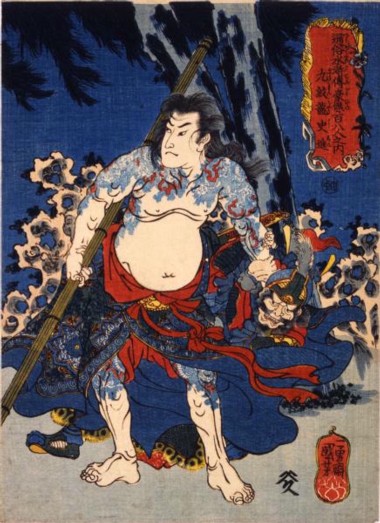Forget eagles, anchors, Mom, portraits of Elvis, and promises to love “Winona Forever.” Decorative ink—exquisite in detail, comprehensive in design, and symbolic in concept—can be art. Skin Deep: Tattooed Warriors and Fantastic Beasts, at the D’Amour Museum of Fine Arts in Springfield, showcases some spectacular tattoos, in a selection of Japanese woodblock prints by Utagawa Kuniyoshi (1798-1861). Some prints show legendary heroes flaunting full body suits; others depict mythical creatures marked with intricate patterns still seen in the tattoos of today.
During the nineteenth century, the Japanese adaptation of a fourteenth-century Chinese novel, Suikoden, “created a craze similar to the Beatlemania phenomenon in America in the 1960s,” explains Julia Courtney, Curator of Art at the Springfield Museums. “Everything connected with the Suikoden was considered iki, or ‘cool’ and ‘trendy’.” And something truly trend-setting that emerged from this fad was Kuniyoshi’s series of prints illustrating “One Hundred and Eight Heroes of the Suikoden.”
Kuniyoshi’s background combined art and craft. Born into a family of fabric dyers, he saw how complex textile patterns were designed and how multiple printings produced multi-colored cloth. Then, apprenticed to a studio specializing in prints of famous actors, he studied how drama could be compressed and character could be conveyed in portrait images. When a friend suggested he try traditional Japanese warriors as his subject matter, Kuniyoshi might well have shouted “Eureka!” He developed his own style of action figure—closely cropped and tightly framed, brightly colored and densely packed with patterns, animated by diagonal lines, and emphasizing everything masculine in the physique of the warriors, including an array of full-body tattoos. He achieved major success with this style, and prints of his heroic warriors became very, very popular. Life imitated art: many young men were so enamored of Kuniyoshi’s images that they had designs replicating his warriors tattooed on their own bodies.
So, along with a dramatic style of depicting the heroes of the Suikoden, Kuniyoshi also invented a fashion of decorative body art. “Kuniyoshi gave his cast of characters elaborate, full-body tattoos that were simply not done at that time,” explains tattoo artist Scot Padgett, owner of Living Art Studio in Northampton. Prior to Kuniyoshi’s tattooed warriors, he says, tattoos in Japan were based on kanji, that is, on pictographs or ideograms, using lettering as a symbolic art form. (And prior to that, tattoos were relegated to criminals, who were inked on their faces or their arms, as a sign of shame, specifically to ostracize the offender. But that’s another story…)
“As a culture, the Japanese may have been first to take the premise of the tattoo and turn it into an art form,” notes Padgett. “A lot of Kuniyoshi’s designs are being used to this very day by tattoo aficionados.” Check out the repeating swirls of waves, the bursting foam, and the scales on the giant fish in “Tametomo Rescued from the Shipwreck.” Look at the stylized lightning bolts in “Shinrai, the Thunder God.” The stories and the symbolism of Tametomo and Shinrai may be specific to Japanese culture, but the tattoo designs that they, and the various inked warriors, inspire are here and now.
Now, meet Kuniyoshi’s tattooed warriors. Roshi Yensei displays a splendid back view tattooed with peonies and Chinese lion-dogs, rendered in a style that continues to influence twenty-first-century tattoo artists. One of the most popular Suikoden heroes, Kumonryu Shishin, was the son of a wealthy landowner who, like Robin Hood, championed the poor and fought against the corruption and greed of the rich. His name translates as “Nine-Dragoned,” referring to his body-covering dragon tattoos. (The Girl with the Dragon Tattoo might well be jealous.)
And then there is “The Flower Priest,” with his shoulders and thighs tattooed with cherry blossoms and a Buddhist rosary draped over his bulging muscles. Kwaosho Rochisin, a military captain who became a monk when accused of murder and threatened with death, demonstrates his superhuman strength by splitting a pine tree in half with a metal bar while pinning a demon underfoot. His portrayal also encapsulates Kuniyoshi’s characteristic style: strong diagonal lines help emphasize the swash-buckling action and the dark blue-green of the broken pine tree contrasts with a range of red, rose and pink tones in a lively play of color.
With his obvious flair for finding the dramatic moment, Kuniyoshi was a master storyteller who explored legends and folklore other than the Suikoden. “Making Magic for Revenge on Yoshimitsu on Behalf of His Father” describes an adventure of the Toad Magician, who contains and strategically spews out the life force that animates all creatures. Poignantly gruesome, “The Ama and the Buddha Crystal” illustrates the saga of an Ama, a female deep-sea diver, who sacrifices herself to retrieve a magic gem stolen by the Dragon King and stored at the bottom of the ocean.
While dragons and other mythical beasts abound in Kuniyoshi’s prints, he also depicted real animals, some monstrous in size and scale. “Crowds Viewing the Captured Whale” balances its asymmetry, with the huge, dark mound of the whale echoed in the silhouette of Mt. Fuji, while the whale’s eye and gills visually resonate with the small boats clustered on the right. This image also carries historical interest, documenting a time when traditional Japanese whaling suffered due to the expanding Western whaling industry. With its window on the real world, however, as well as its areas empty of patterning, this print stands apart from most of the others, with their focus on the fantastic.
Skin Deep is not a large-scale exhibition, but an intimate display of prints centered on an appealing, accessible theme that creates an occasion to acknowledge “Nice tats!” across cultures.•
Skin Deep: Tattooed Warriors and Fantastic Beasts, Print Corridor, D’Amour Museum of Fine Arts, Springfield. Through December 15, 2013.



